Barriers to Effective End of Life Nursing Care in ICU
VerifiedAdded on 2023/03/31
|13
|3297
|177
AI Summary
This research proposal aims to investigate the barriers and intricacies of providing effective end-of-life nursing care in intensive care units (ICUs). It explores the challenges faced by ICU nurses in decision-making and communication, and the impact on patient and family well-being. The study aims to improve understanding and inform the development of educational resources and clinical standards for end-of-life care in ICUs.
Contribute Materials
Your contribution can guide someone’s learning journey. Share your
documents today.
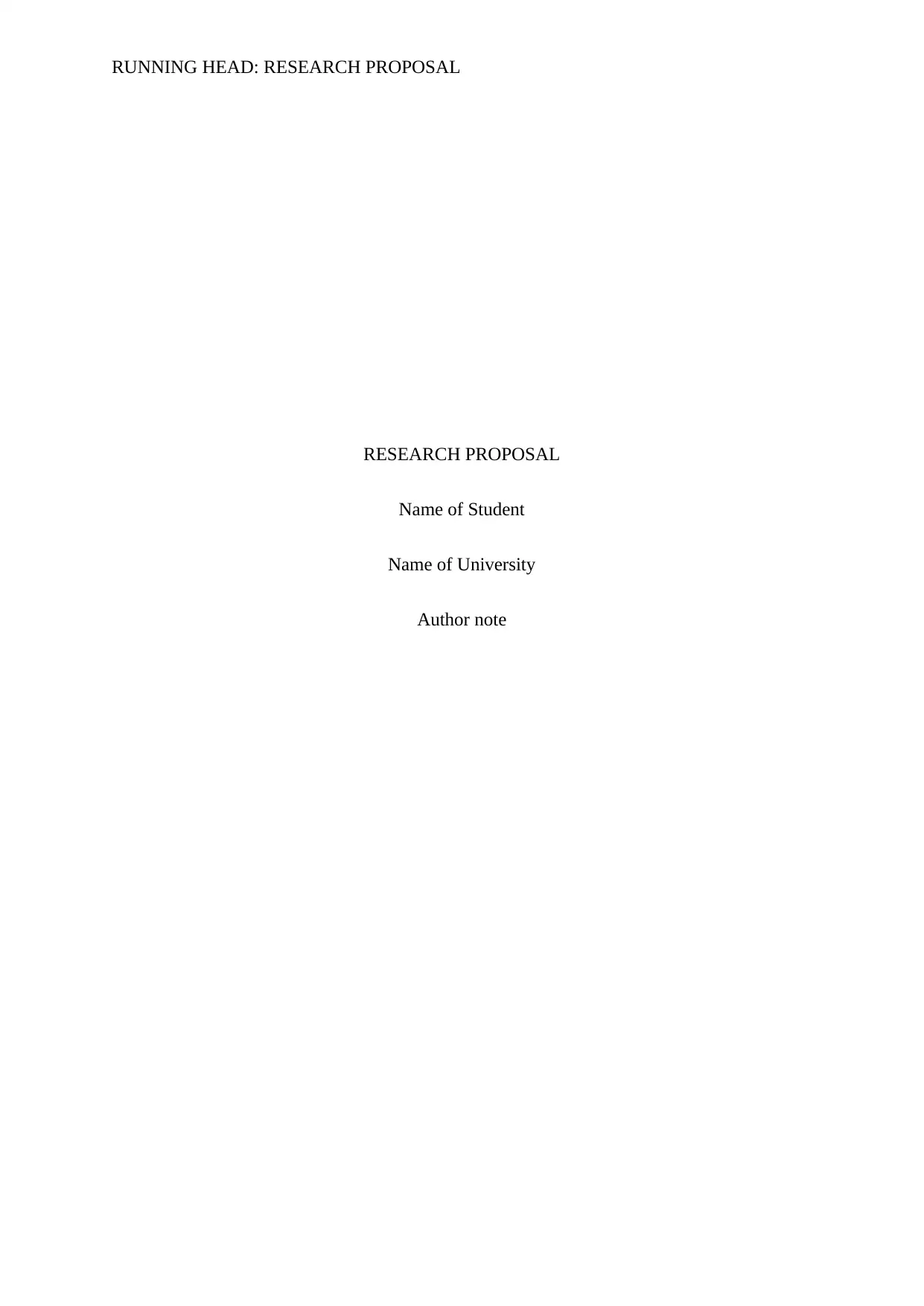
RUNNING HEAD: RESEARCH PROPOSAL
RESEARCH PROPOSAL
Name of Student
Name of University
Author note
RESEARCH PROPOSAL
Name of Student
Name of University
Author note
Secure Best Marks with AI Grader
Need help grading? Try our AI Grader for instant feedback on your assignments.
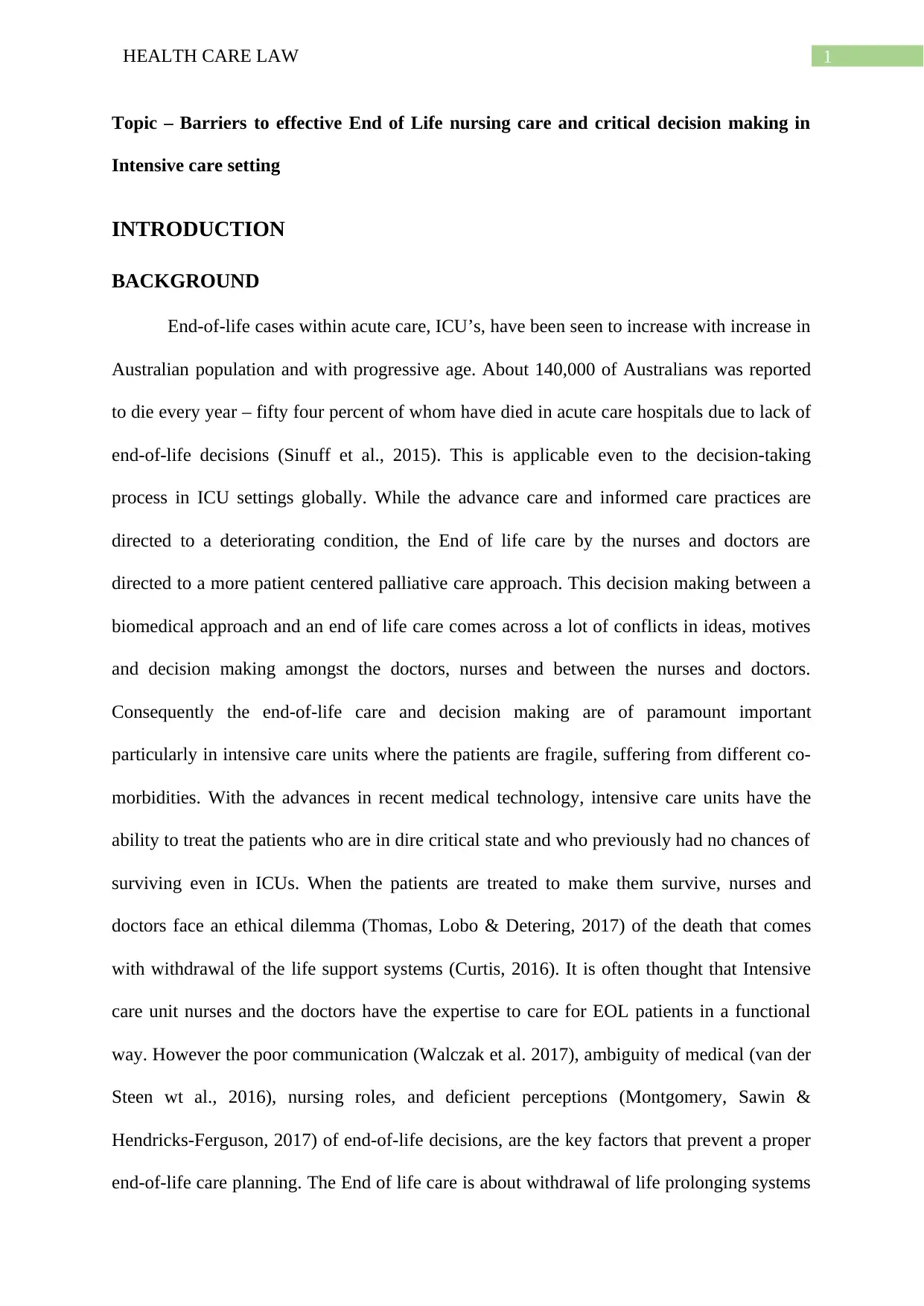
1HEALTH CARE LAW
Topic – Barriers to effective End of Life nursing care and critical decision making in
Intensive care setting
INTRODUCTION
BACKGROUND
End-of-life cases within acute care, ICU’s, have been seen to increase with increase in
Australian population and with progressive age. About 140,000 of Australians was reported
to die every year – fifty four percent of whom have died in acute care hospitals due to lack of
end-of-life decisions (Sinuff et al., 2015). This is applicable even to the decision-taking
process in ICU settings globally. While the advance care and informed care practices are
directed to a deteriorating condition, the End of life care by the nurses and doctors are
directed to a more patient centered palliative care approach. This decision making between a
biomedical approach and an end of life care comes across a lot of conflicts in ideas, motives
and decision making amongst the doctors, nurses and between the nurses and doctors.
Consequently the end-of-life care and decision making are of paramount important
particularly in intensive care units where the patients are fragile, suffering from different co-
morbidities. With the advances in recent medical technology, intensive care units have the
ability to treat the patients who are in dire critical state and who previously had no chances of
surviving even in ICUs. When the patients are treated to make them survive, nurses and
doctors face an ethical dilemma (Thomas, Lobo & Detering, 2017) of the death that comes
with withdrawal of the life support systems (Curtis, 2016). It is often thought that Intensive
care unit nurses and the doctors have the expertise to care for EOL patients in a functional
way. However the poor communication (Walczak et al. 2017), ambiguity of medical (van der
Steen wt al., 2016), nursing roles, and deficient perceptions (Montgomery, Sawin &
Hendricks-Ferguson, 2017) of end-of-life decisions, are the key factors that prevent a proper
end-of-life care planning. The End of life care is about withdrawal of life prolonging systems
Topic – Barriers to effective End of Life nursing care and critical decision making in
Intensive care setting
INTRODUCTION
BACKGROUND
End-of-life cases within acute care, ICU’s, have been seen to increase with increase in
Australian population and with progressive age. About 140,000 of Australians was reported
to die every year – fifty four percent of whom have died in acute care hospitals due to lack of
end-of-life decisions (Sinuff et al., 2015). This is applicable even to the decision-taking
process in ICU settings globally. While the advance care and informed care practices are
directed to a deteriorating condition, the End of life care by the nurses and doctors are
directed to a more patient centered palliative care approach. This decision making between a
biomedical approach and an end of life care comes across a lot of conflicts in ideas, motives
and decision making amongst the doctors, nurses and between the nurses and doctors.
Consequently the end-of-life care and decision making are of paramount important
particularly in intensive care units where the patients are fragile, suffering from different co-
morbidities. With the advances in recent medical technology, intensive care units have the
ability to treat the patients who are in dire critical state and who previously had no chances of
surviving even in ICUs. When the patients are treated to make them survive, nurses and
doctors face an ethical dilemma (Thomas, Lobo & Detering, 2017) of the death that comes
with withdrawal of the life support systems (Curtis, 2016). It is often thought that Intensive
care unit nurses and the doctors have the expertise to care for EOL patients in a functional
way. However the poor communication (Walczak et al. 2017), ambiguity of medical (van der
Steen wt al., 2016), nursing roles, and deficient perceptions (Montgomery, Sawin &
Hendricks-Ferguson, 2017) of end-of-life decisions, are the key factors that prevent a proper
end-of-life care planning. The End of life care is about withdrawal of life prolonging systems

2HEALTH CARE LAW
that alleviates pain and discomfort and is replaced by a patient centered humanistic care with
life shortening possibilities.
These end of life decisions asks for a responsibility from the families, intensive care
staffs and decisions are taken without patient’s input which is again an ethical dilemma. This
might place a significant emotional burden on the patient and that is why end of life decisions
are often associated with stress. Despite clinical experience and knowledge, there is a fear of
abandoning the patient’s hope prematurely that frequently cite inadequate perception
(Wessman, Sona & Schallom, 2017) preparation and decision regarding end of life decisions.
Empirical data and information about the end-of-life care planning is missing. With
increasing incidents of EOL decision making, an understanding ICU nurses experiences is
needed. Insights to nursing experiences can be beneficial to an informed practice. It is also
pivotal to the development of an educational resource with the elevation of clinical standards
regarding end-of-life care.
RESEARCH PROBLEM
Issues involving end-of-life decision making have been a great barrier to EOL and
palliative care. The nurses have described their personal feelings like stress (Katz & Johnson,
2016), anger, frustration sadness, moral distress and helplessness. This moral distress and
cognitive drawback is often associated with nurses being unable to influence the EOL
decisions and the more precisely, the decision-making processes. EOL care replaces the
aggressive care that is not benefiting for them. Aggressive care (Wright et al., 2016) leads to
conflicts with patients and their families’ but they are often indecisive about the treatment
termination. Moral distress (Dzeng et al., 2016) has been reported to be associated with ICU
nurses’ ineffectiveness to decide between life prolonging or life shortening treatments. Moral
distress has been seen a serious barrier in Intensive care unit nursing and especially to end of
that alleviates pain and discomfort and is replaced by a patient centered humanistic care with
life shortening possibilities.
These end of life decisions asks for a responsibility from the families, intensive care
staffs and decisions are taken without patient’s input which is again an ethical dilemma. This
might place a significant emotional burden on the patient and that is why end of life decisions
are often associated with stress. Despite clinical experience and knowledge, there is a fear of
abandoning the patient’s hope prematurely that frequently cite inadequate perception
(Wessman, Sona & Schallom, 2017) preparation and decision regarding end of life decisions.
Empirical data and information about the end-of-life care planning is missing. With
increasing incidents of EOL decision making, an understanding ICU nurses experiences is
needed. Insights to nursing experiences can be beneficial to an informed practice. It is also
pivotal to the development of an educational resource with the elevation of clinical standards
regarding end-of-life care.
RESEARCH PROBLEM
Issues involving end-of-life decision making have been a great barrier to EOL and
palliative care. The nurses have described their personal feelings like stress (Katz & Johnson,
2016), anger, frustration sadness, moral distress and helplessness. This moral distress and
cognitive drawback is often associated with nurses being unable to influence the EOL
decisions and the more precisely, the decision-making processes. EOL care replaces the
aggressive care that is not benefiting for them. Aggressive care (Wright et al., 2016) leads to
conflicts with patients and their families’ but they are often indecisive about the treatment
termination. Moral distress (Dzeng et al., 2016) has been reported to be associated with ICU
nurses’ ineffectiveness to decide between life prolonging or life shortening treatments. Moral
distress has been seen a serious barrier in Intensive care unit nursing and especially to end of
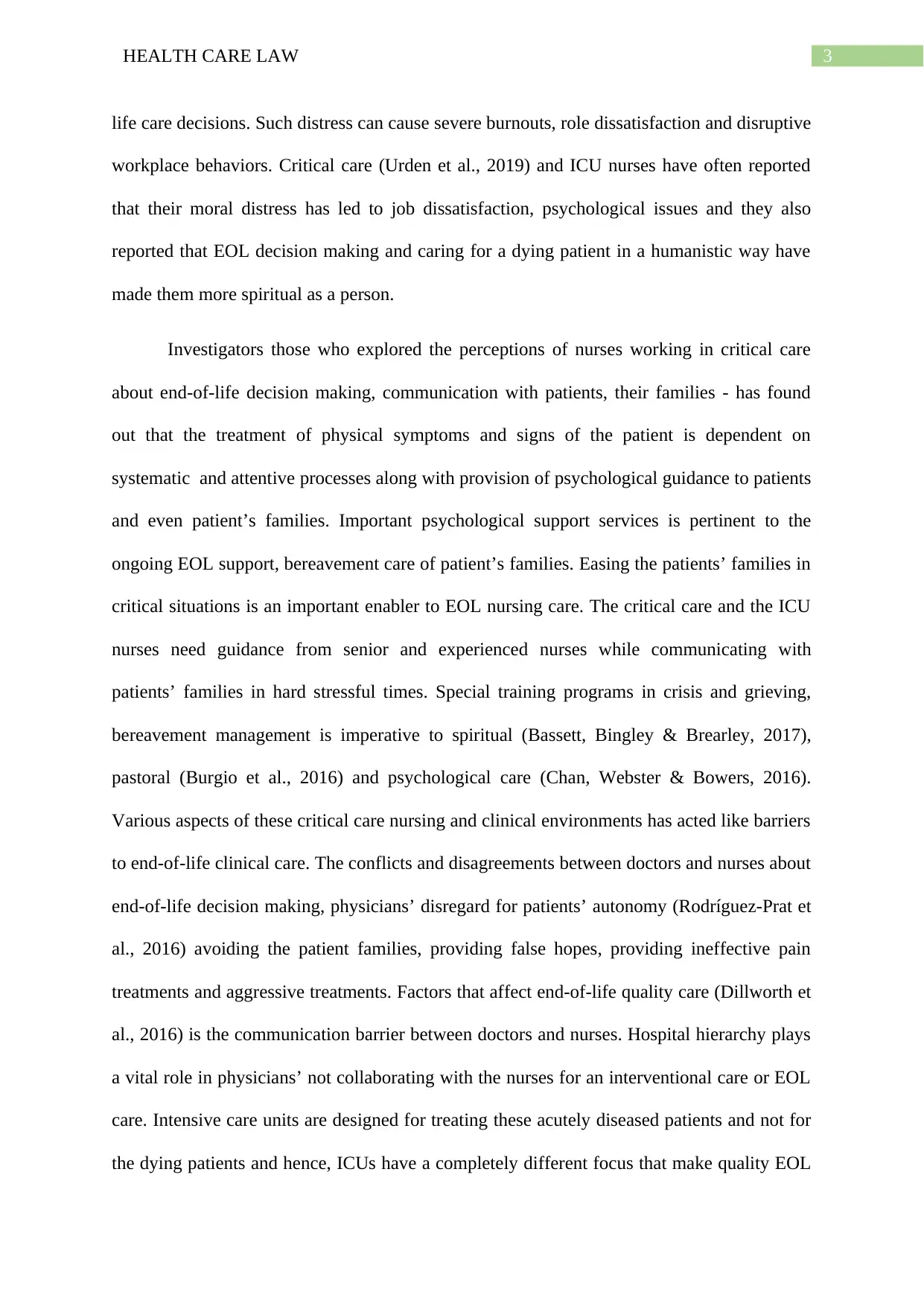
3HEALTH CARE LAW
life care decisions. Such distress can cause severe burnouts, role dissatisfaction and disruptive
workplace behaviors. Critical care (Urden et al., 2019) and ICU nurses have often reported
that their moral distress has led to job dissatisfaction, psychological issues and they also
reported that EOL decision making and caring for a dying patient in a humanistic way have
made them more spiritual as a person.
Investigators those who explored the perceptions of nurses working in critical care
about end-of-life decision making, communication with patients, their families - has found
out that the treatment of physical symptoms and signs of the patient is dependent on
systematic and attentive processes along with provision of psychological guidance to patients
and even patient’s families. Important psychological support services is pertinent to the
ongoing EOL support, bereavement care of patient’s families. Easing the patients’ families in
critical situations is an important enabler to EOL nursing care. The critical care and the ICU
nurses need guidance from senior and experienced nurses while communicating with
patients’ families in hard stressful times. Special training programs in crisis and grieving,
bereavement management is imperative to spiritual (Bassett, Bingley & Brearley, 2017),
pastoral (Burgio et al., 2016) and psychological care (Chan, Webster & Bowers, 2016).
Various aspects of these critical care nursing and clinical environments has acted like barriers
to end-of-life clinical care. The conflicts and disagreements between doctors and nurses about
end-of-life decision making, physicians’ disregard for patients’ autonomy (Rodríguez-Prat et
al., 2016) avoiding the patient families, providing false hopes, providing ineffective pain
treatments and aggressive treatments. Factors that affect end-of-life quality care (Dillworth et
al., 2016) is the communication barrier between doctors and nurses. Hospital hierarchy plays
a vital role in physicians’ not collaborating with the nurses for an interventional care or EOL
care. Intensive care units are designed for treating these acutely diseased patients and not for
the dying patients and hence, ICUs have a completely different focus that make quality EOL
life care decisions. Such distress can cause severe burnouts, role dissatisfaction and disruptive
workplace behaviors. Critical care (Urden et al., 2019) and ICU nurses have often reported
that their moral distress has led to job dissatisfaction, psychological issues and they also
reported that EOL decision making and caring for a dying patient in a humanistic way have
made them more spiritual as a person.
Investigators those who explored the perceptions of nurses working in critical care
about end-of-life decision making, communication with patients, their families - has found
out that the treatment of physical symptoms and signs of the patient is dependent on
systematic and attentive processes along with provision of psychological guidance to patients
and even patient’s families. Important psychological support services is pertinent to the
ongoing EOL support, bereavement care of patient’s families. Easing the patients’ families in
critical situations is an important enabler to EOL nursing care. The critical care and the ICU
nurses need guidance from senior and experienced nurses while communicating with
patients’ families in hard stressful times. Special training programs in crisis and grieving,
bereavement management is imperative to spiritual (Bassett, Bingley & Brearley, 2017),
pastoral (Burgio et al., 2016) and psychological care (Chan, Webster & Bowers, 2016).
Various aspects of these critical care nursing and clinical environments has acted like barriers
to end-of-life clinical care. The conflicts and disagreements between doctors and nurses about
end-of-life decision making, physicians’ disregard for patients’ autonomy (Rodríguez-Prat et
al., 2016) avoiding the patient families, providing false hopes, providing ineffective pain
treatments and aggressive treatments. Factors that affect end-of-life quality care (Dillworth et
al., 2016) is the communication barrier between doctors and nurses. Hospital hierarchy plays
a vital role in physicians’ not collaborating with the nurses for an interventional care or EOL
care. Intensive care units are designed for treating these acutely diseased patients and not for
the dying patients and hence, ICUs have a completely different focus that make quality EOL
Secure Best Marks with AI Grader
Need help grading? Try our AI Grader for instant feedback on your assignments.
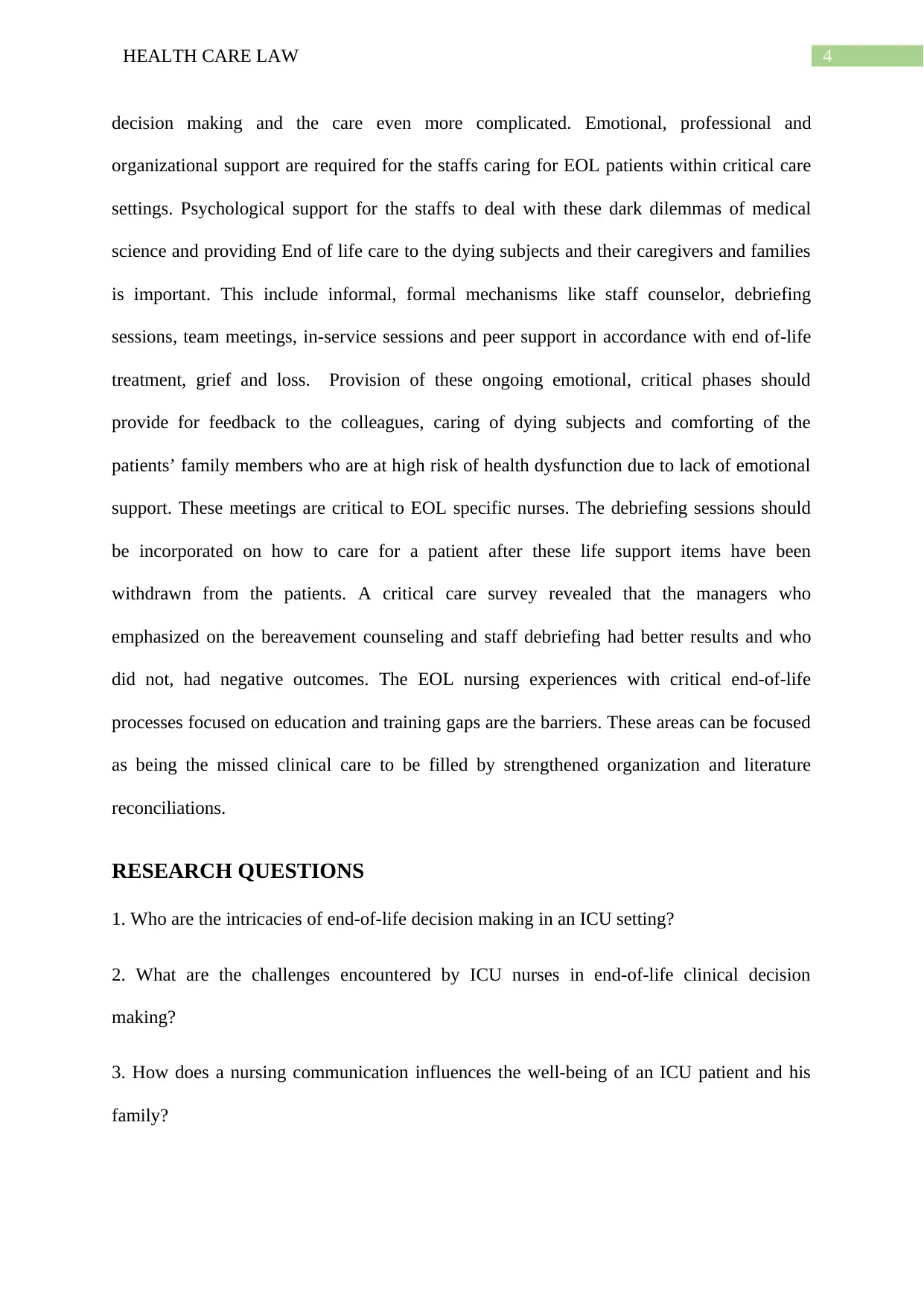
4HEALTH CARE LAW
decision making and the care even more complicated. Emotional, professional and
organizational support are required for the staffs caring for EOL patients within critical care
settings. Psychological support for the staffs to deal with these dark dilemmas of medical
science and providing End of life care to the dying subjects and their caregivers and families
is important. This include informal, formal mechanisms like staff counselor, debriefing
sessions, team meetings, in-service sessions and peer support in accordance with end of-life
treatment, grief and loss. Provision of these ongoing emotional, critical phases should
provide for feedback to the colleagues, caring of dying subjects and comforting of the
patients’ family members who are at high risk of health dysfunction due to lack of emotional
support. These meetings are critical to EOL specific nurses. The debriefing sessions should
be incorporated on how to care for a patient after these life support items have been
withdrawn from the patients. A critical care survey revealed that the managers who
emphasized on the bereavement counseling and staff debriefing had better results and who
did not, had negative outcomes. The EOL nursing experiences with critical end-of-life
processes focused on education and training gaps are the barriers. These areas can be focused
as being the missed clinical care to be filled by strengthened organization and literature
reconciliations.
RESEARCH QUESTIONS
1. Who are the intricacies of end-of-life decision making in an ICU setting?
2. What are the challenges encountered by ICU nurses in end-of-life clinical decision
making?
3. How does a nursing communication influences the well-being of an ICU patient and his
family?
decision making and the care even more complicated. Emotional, professional and
organizational support are required for the staffs caring for EOL patients within critical care
settings. Psychological support for the staffs to deal with these dark dilemmas of medical
science and providing End of life care to the dying subjects and their caregivers and families
is important. This include informal, formal mechanisms like staff counselor, debriefing
sessions, team meetings, in-service sessions and peer support in accordance with end of-life
treatment, grief and loss. Provision of these ongoing emotional, critical phases should
provide for feedback to the colleagues, caring of dying subjects and comforting of the
patients’ family members who are at high risk of health dysfunction due to lack of emotional
support. These meetings are critical to EOL specific nurses. The debriefing sessions should
be incorporated on how to care for a patient after these life support items have been
withdrawn from the patients. A critical care survey revealed that the managers who
emphasized on the bereavement counseling and staff debriefing had better results and who
did not, had negative outcomes. The EOL nursing experiences with critical end-of-life
processes focused on education and training gaps are the barriers. These areas can be focused
as being the missed clinical care to be filled by strengthened organization and literature
reconciliations.
RESEARCH QUESTIONS
1. Who are the intricacies of end-of-life decision making in an ICU setting?
2. What are the challenges encountered by ICU nurses in end-of-life clinical decision
making?
3. How does a nursing communication influences the well-being of an ICU patient and his
family?
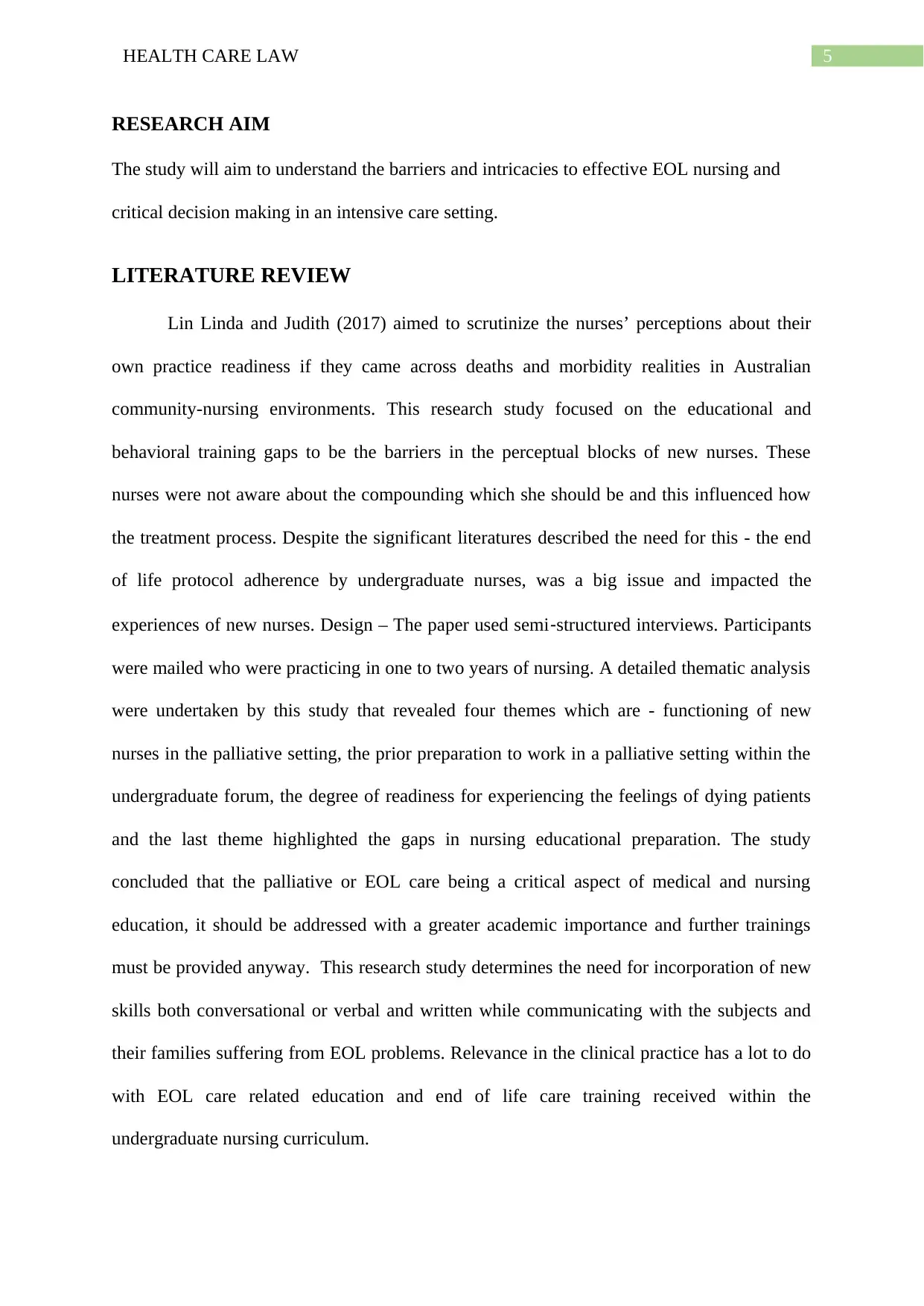
5HEALTH CARE LAW
RESEARCH AIM
The study will aim to understand the barriers and intricacies to effective EOL nursing and
critical decision making in an intensive care setting.
LITERATURE REVIEW
Lin Linda and Judith (2017) aimed to scrutinize the nurses’ perceptions about their
own practice readiness if they came across deaths and morbidity realities in Australian
community-nursing environments. This research study focused on the educational and
behavioral training gaps to be the barriers in the perceptual blocks of new nurses. These
nurses were not aware about the compounding which she should be and this influenced how
the treatment process. Despite the significant literatures described the need for this - the end
of life protocol adherence by undergraduate nurses, was a big issue and impacted the
experiences of new nurses. Design – The paper used semi‐structured interviews. Participants
were mailed who were practicing in one to two years of nursing. A detailed thematic analysis
were undertaken by this study that revealed four themes which are - functioning of new
nurses in the palliative setting, the prior preparation to work in a palliative setting within the
undergraduate forum, the degree of readiness for experiencing the feelings of dying patients
and the last theme highlighted the gaps in nursing educational preparation. The study
concluded that the palliative or EOL care being a critical aspect of medical and nursing
education, it should be addressed with a greater academic importance and further trainings
must be provided anyway. This research study determines the need for incorporation of new
skills both conversational or verbal and written while communicating with the subjects and
their families suffering from EOL problems. Relevance in the clinical practice has a lot to do
with EOL care related education and end of life care training received within the
undergraduate nursing curriculum.
RESEARCH AIM
The study will aim to understand the barriers and intricacies to effective EOL nursing and
critical decision making in an intensive care setting.
LITERATURE REVIEW
Lin Linda and Judith (2017) aimed to scrutinize the nurses’ perceptions about their
own practice readiness if they came across deaths and morbidity realities in Australian
community-nursing environments. This research study focused on the educational and
behavioral training gaps to be the barriers in the perceptual blocks of new nurses. These
nurses were not aware about the compounding which she should be and this influenced how
the treatment process. Despite the significant literatures described the need for this - the end
of life protocol adherence by undergraduate nurses, was a big issue and impacted the
experiences of new nurses. Design – The paper used semi‐structured interviews. Participants
were mailed who were practicing in one to two years of nursing. A detailed thematic analysis
were undertaken by this study that revealed four themes which are - functioning of new
nurses in the palliative setting, the prior preparation to work in a palliative setting within the
undergraduate forum, the degree of readiness for experiencing the feelings of dying patients
and the last theme highlighted the gaps in nursing educational preparation. The study
concluded that the palliative or EOL care being a critical aspect of medical and nursing
education, it should be addressed with a greater academic importance and further trainings
must be provided anyway. This research study determines the need for incorporation of new
skills both conversational or verbal and written while communicating with the subjects and
their families suffering from EOL problems. Relevance in the clinical practice has a lot to do
with EOL care related education and end of life care training received within the
undergraduate nursing curriculum.

6HEALTH CARE LAW
Boyd et al. aimed to understand these oncology nurses’ behavior and the attitudes
toward the EOL care, their overall experiences regarding management of terminal patients,
hospice meetings with the families and patients, and palliative care’s use in the practices.
They used a descriptive survey design. The sample size had thirty one oncology nurses. The
Nurses completed the survey whose questions were based on their action areas. The main
Variables were based on their perception toward EOL care and palliative nursing experiences
with the terminal patients. The findings, in spite of having the positively inclined attitudes
toward staying in a hospice and having reported repetitive discussions with the patient and
patient families showed missed opportunities regarding the discussions, the patient referrals
and patient stay in hospice. On the average, the nurses who cared for about seven terminal
patients in a period of three-months with a hospice care to patients and to their family
members. The nurses spoke of their experiences in hospice care and how it has help grow as
a nurse. Specific types of palliative care including passive and active listening, requesting
elevated pain medications along with aromatherapy and the guided imagery was found be
useful by the study. The study concluded that the missed opportunities can reflect nursing
attitudes towards EOL care. However, the lack of patient autonomy and their family’s
acceptance of the EOL care is the most critical barrier to hospice. The study implies that the
strategies in enabling nurses requires stronger voice in critical time to support their patients
and to develop a supportive practice in order to ensure the changes.
Garner, Goodwin and Mcsweeney (2013) – aimed to study the perceptual deficits of
nurse care regarding the end-of-life management in hospital environment. They conducted a
naturalistic, descriptive, qualitative research using interviews in order to capture the nurse’s
understandings, perceptions and beliefs about the end-of-life process in a hospital setting.
Qualitative techniques allowed the study researchers to explore opinions and experiences of
EOL pragmatic approaches. Without the correct communication skills, the families and
Boyd et al. aimed to understand these oncology nurses’ behavior and the attitudes
toward the EOL care, their overall experiences regarding management of terminal patients,
hospice meetings with the families and patients, and palliative care’s use in the practices.
They used a descriptive survey design. The sample size had thirty one oncology nurses. The
Nurses completed the survey whose questions were based on their action areas. The main
Variables were based on their perception toward EOL care and palliative nursing experiences
with the terminal patients. The findings, in spite of having the positively inclined attitudes
toward staying in a hospice and having reported repetitive discussions with the patient and
patient families showed missed opportunities regarding the discussions, the patient referrals
and patient stay in hospice. On the average, the nurses who cared for about seven terminal
patients in a period of three-months with a hospice care to patients and to their family
members. The nurses spoke of their experiences in hospice care and how it has help grow as
a nurse. Specific types of palliative care including passive and active listening, requesting
elevated pain medications along with aromatherapy and the guided imagery was found be
useful by the study. The study concluded that the missed opportunities can reflect nursing
attitudes towards EOL care. However, the lack of patient autonomy and their family’s
acceptance of the EOL care is the most critical barrier to hospice. The study implies that the
strategies in enabling nurses requires stronger voice in critical time to support their patients
and to develop a supportive practice in order to ensure the changes.
Garner, Goodwin and Mcsweeney (2013) – aimed to study the perceptual deficits of
nurse care regarding the end-of-life management in hospital environment. They conducted a
naturalistic, descriptive, qualitative research using interviews in order to capture the nurse’s
understandings, perceptions and beliefs about the end-of-life process in a hospital setting.
Qualitative techniques allowed the study researchers to explore opinions and experiences of
EOL pragmatic approaches. Without the correct communication skills, the families and
Paraphrase This Document
Need a fresh take? Get an instant paraphrase of this document with our AI Paraphraser
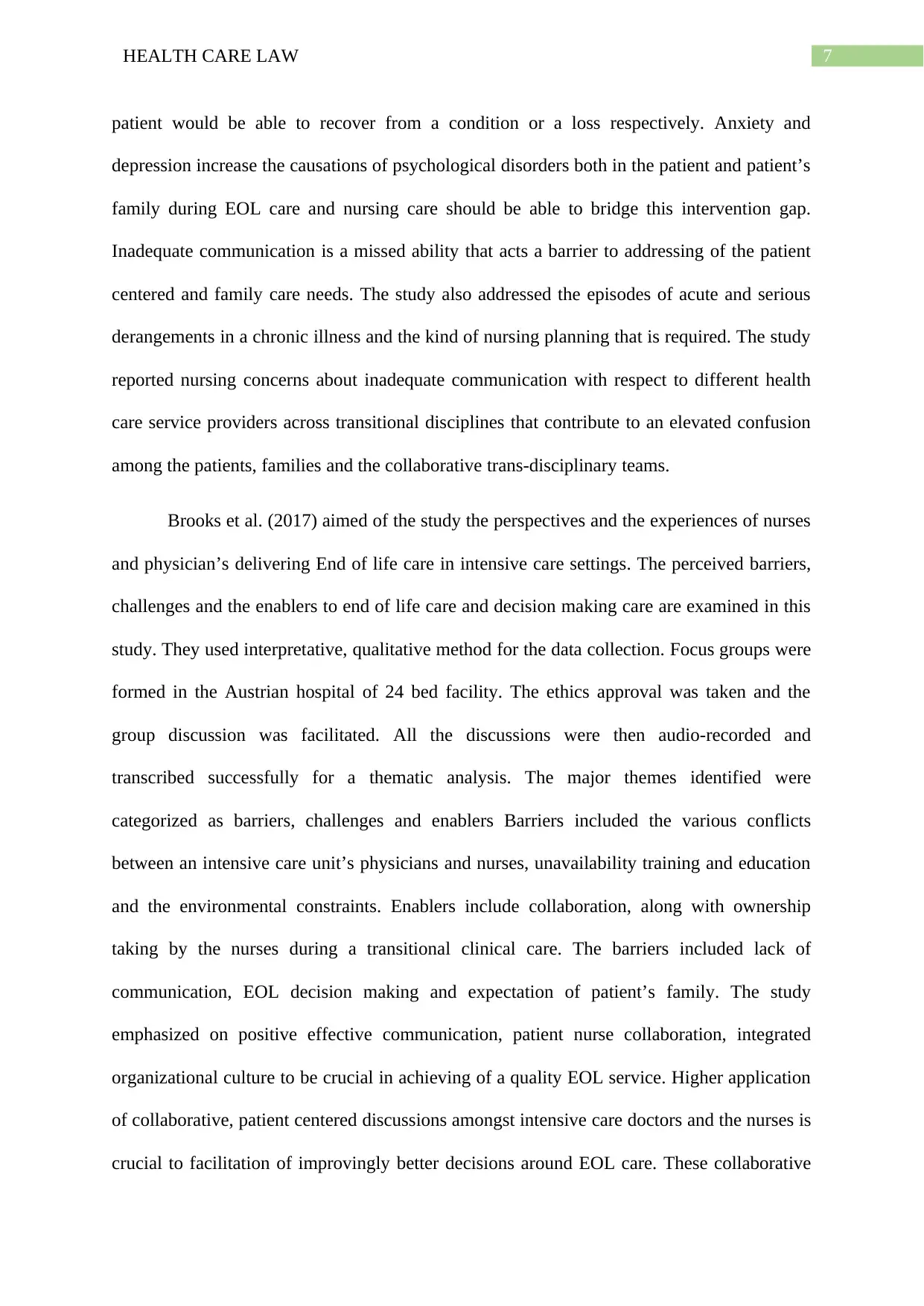
7HEALTH CARE LAW
patient would be able to recover from a condition or a loss respectively. Anxiety and
depression increase the causations of psychological disorders both in the patient and patient’s
family during EOL care and nursing care should be able to bridge this intervention gap.
Inadequate communication is a missed ability that acts a barrier to addressing of the patient
centered and family care needs. The study also addressed the episodes of acute and serious
derangements in a chronic illness and the kind of nursing planning that is required. The study
reported nursing concerns about inadequate communication with respect to different health
care service providers across transitional disciplines that contribute to an elevated confusion
among the patients, families and the collaborative trans-disciplinary teams.
Brooks et al. (2017) aimed of the study the perspectives and the experiences of nurses
and physician’s delivering End of life care in intensive care settings. The perceived barriers,
challenges and the enablers to end of life care and decision making care are examined in this
study. They used interpretative, qualitative method for the data collection. Focus groups were
formed in the Austrian hospital of 24 bed facility. The ethics approval was taken and the
group discussion was facilitated. All the discussions were then audio-recorded and
transcribed successfully for a thematic analysis. The major themes identified were
categorized as barriers, challenges and enablers Barriers included the various conflicts
between an intensive care unit’s physicians and nurses, unavailability training and education
and the environmental constraints. Enablers include collaboration, along with ownership
taking by the nurses during a transitional clinical care. The barriers included lack of
communication, EOL decision making and expectation of patient’s family. The study
emphasized on positive effective communication, patient nurse collaboration, integrated
organizational culture to be crucial in achieving of a quality EOL service. Higher application
of collaborative, patient centered discussions amongst intensive care doctors and the nurses is
crucial to facilitation of improvingly better decisions around EOL care. These collaborative
patient would be able to recover from a condition or a loss respectively. Anxiety and
depression increase the causations of psychological disorders both in the patient and patient’s
family during EOL care and nursing care should be able to bridge this intervention gap.
Inadequate communication is a missed ability that acts a barrier to addressing of the patient
centered and family care needs. The study also addressed the episodes of acute and serious
derangements in a chronic illness and the kind of nursing planning that is required. The study
reported nursing concerns about inadequate communication with respect to different health
care service providers across transitional disciplines that contribute to an elevated confusion
among the patients, families and the collaborative trans-disciplinary teams.
Brooks et al. (2017) aimed of the study the perspectives and the experiences of nurses
and physician’s delivering End of life care in intensive care settings. The perceived barriers,
challenges and the enablers to end of life care and decision making care are examined in this
study. They used interpretative, qualitative method for the data collection. Focus groups were
formed in the Austrian hospital of 24 bed facility. The ethics approval was taken and the
group discussion was facilitated. All the discussions were then audio-recorded and
transcribed successfully for a thematic analysis. The major themes identified were
categorized as barriers, challenges and enablers Barriers included the various conflicts
between an intensive care unit’s physicians and nurses, unavailability training and education
and the environmental constraints. Enablers include collaboration, along with ownership
taking by the nurses during a transitional clinical care. The barriers included lack of
communication, EOL decision making and expectation of patient’s family. The study
emphasized on positive effective communication, patient nurse collaboration, integrated
organizational culture to be crucial in achieving of a quality EOL service. Higher application
of collaborative, patient centered discussions amongst intensive care doctors and the nurses is
crucial to facilitation of improvingly better decisions around EOL care. These collaborative
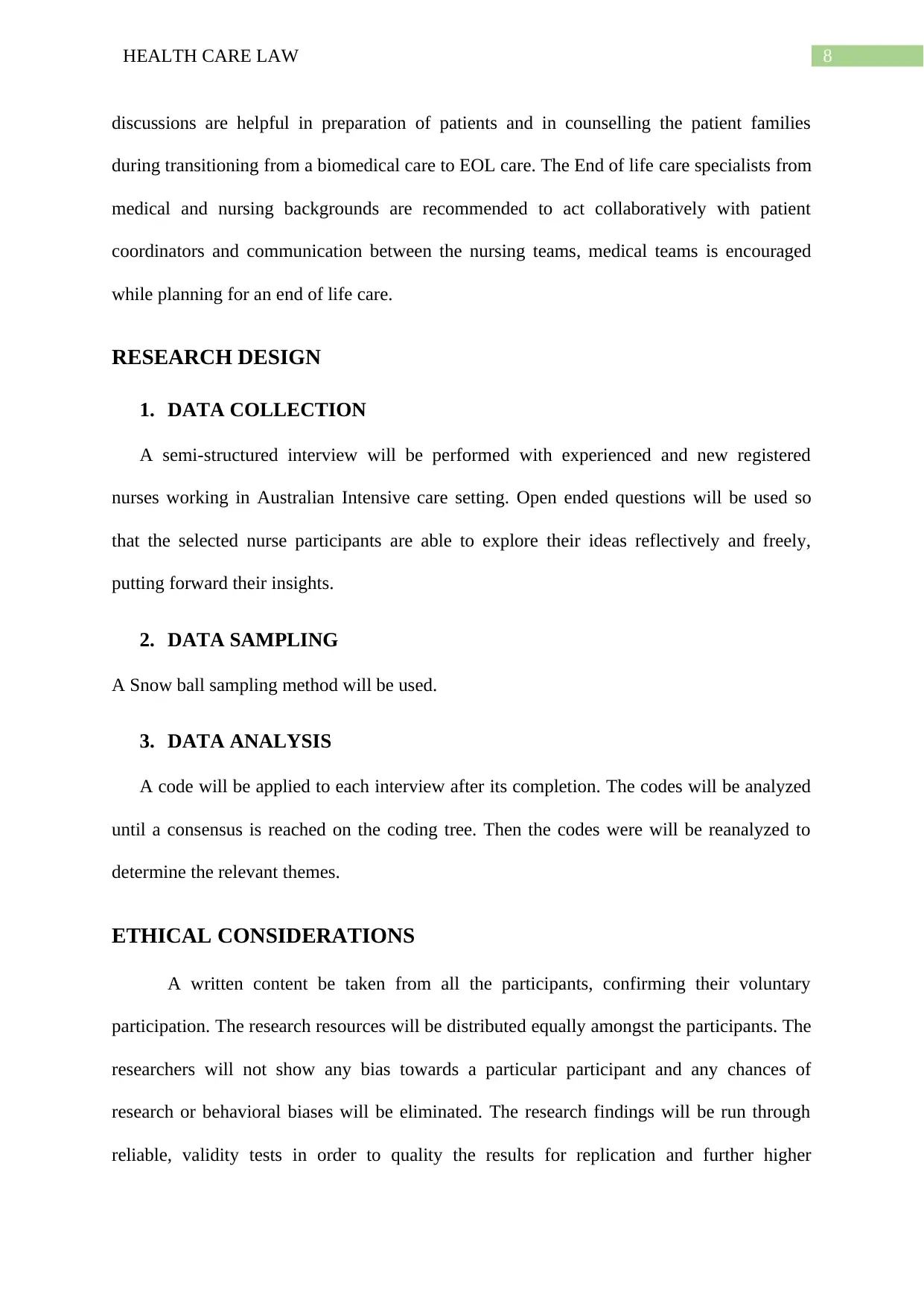
8HEALTH CARE LAW
discussions are helpful in preparation of patients and in counselling the patient families
during transitioning from a biomedical care to EOL care. The End of life care specialists from
medical and nursing backgrounds are recommended to act collaboratively with patient
coordinators and communication between the nursing teams, medical teams is encouraged
while planning for an end of life care.
RESEARCH DESIGN
1. DATA COLLECTION
A semi-structured interview will be performed with experienced and new registered
nurses working in Australian Intensive care setting. Open ended questions will be used so
that the selected nurse participants are able to explore their ideas reflectively and freely,
putting forward their insights.
2. DATA SAMPLING
A Snow ball sampling method will be used.
3. DATA ANALYSIS
A code will be applied to each interview after its completion. The codes will be analyzed
until a consensus is reached on the coding tree. Then the codes were will be reanalyzed to
determine the relevant themes.
ETHICAL CONSIDERATIONS
A written content be taken from all the participants, confirming their voluntary
participation. The research resources will be distributed equally amongst the participants. The
researchers will not show any bias towards a particular participant and any chances of
research or behavioral biases will be eliminated. The research findings will be run through
reliable, validity tests in order to quality the results for replication and further higher
discussions are helpful in preparation of patients and in counselling the patient families
during transitioning from a biomedical care to EOL care. The End of life care specialists from
medical and nursing backgrounds are recommended to act collaboratively with patient
coordinators and communication between the nursing teams, medical teams is encouraged
while planning for an end of life care.
RESEARCH DESIGN
1. DATA COLLECTION
A semi-structured interview will be performed with experienced and new registered
nurses working in Australian Intensive care setting. Open ended questions will be used so
that the selected nurse participants are able to explore their ideas reflectively and freely,
putting forward their insights.
2. DATA SAMPLING
A Snow ball sampling method will be used.
3. DATA ANALYSIS
A code will be applied to each interview after its completion. The codes will be analyzed
until a consensus is reached on the coding tree. Then the codes were will be reanalyzed to
determine the relevant themes.
ETHICAL CONSIDERATIONS
A written content be taken from all the participants, confirming their voluntary
participation. The research resources will be distributed equally amongst the participants. The
researchers will not show any bias towards a particular participant and any chances of
research or behavioral biases will be eliminated. The research findings will be run through
reliable, validity tests in order to quality the results for replication and further higher
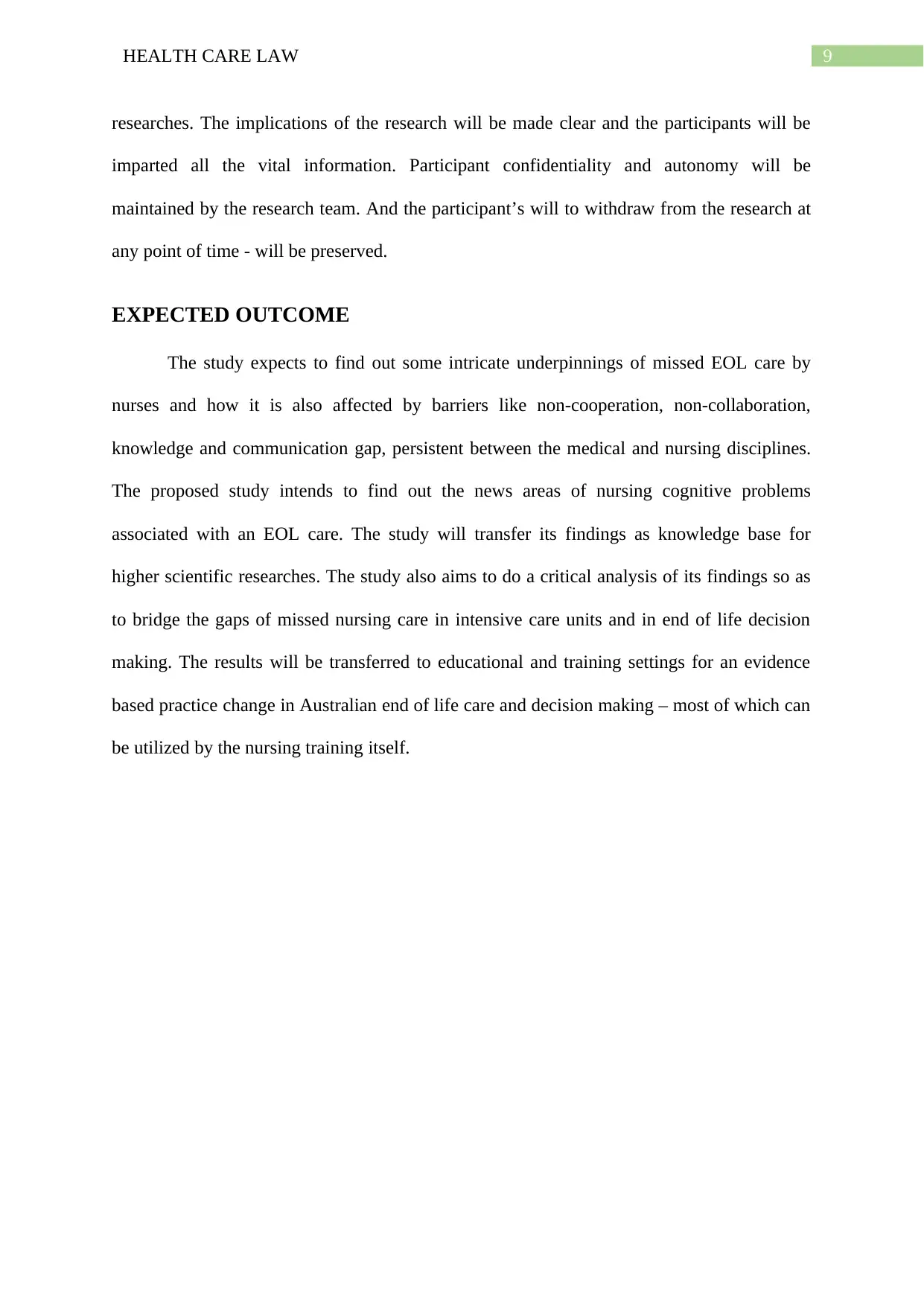
9HEALTH CARE LAW
researches. The implications of the research will be made clear and the participants will be
imparted all the vital information. Participant confidentiality and autonomy will be
maintained by the research team. And the participant’s will to withdraw from the research at
any point of time - will be preserved.
EXPECTED OUTCOME
The study expects to find out some intricate underpinnings of missed EOL care by
nurses and how it is also affected by barriers like non-cooperation, non-collaboration,
knowledge and communication gap, persistent between the medical and nursing disciplines.
The proposed study intends to find out the news areas of nursing cognitive problems
associated with an EOL care. The study will transfer its findings as knowledge base for
higher scientific researches. The study also aims to do a critical analysis of its findings so as
to bridge the gaps of missed nursing care in intensive care units and in end of life decision
making. The results will be transferred to educational and training settings for an evidence
based practice change in Australian end of life care and decision making – most of which can
be utilized by the nursing training itself.
researches. The implications of the research will be made clear and the participants will be
imparted all the vital information. Participant confidentiality and autonomy will be
maintained by the research team. And the participant’s will to withdraw from the research at
any point of time - will be preserved.
EXPECTED OUTCOME
The study expects to find out some intricate underpinnings of missed EOL care by
nurses and how it is also affected by barriers like non-cooperation, non-collaboration,
knowledge and communication gap, persistent between the medical and nursing disciplines.
The proposed study intends to find out the news areas of nursing cognitive problems
associated with an EOL care. The study will transfer its findings as knowledge base for
higher scientific researches. The study also aims to do a critical analysis of its findings so as
to bridge the gaps of missed nursing care in intensive care units and in end of life decision
making. The results will be transferred to educational and training settings for an evidence
based practice change in Australian end of life care and decision making – most of which can
be utilized by the nursing training itself.
Secure Best Marks with AI Grader
Need help grading? Try our AI Grader for instant feedback on your assignments.
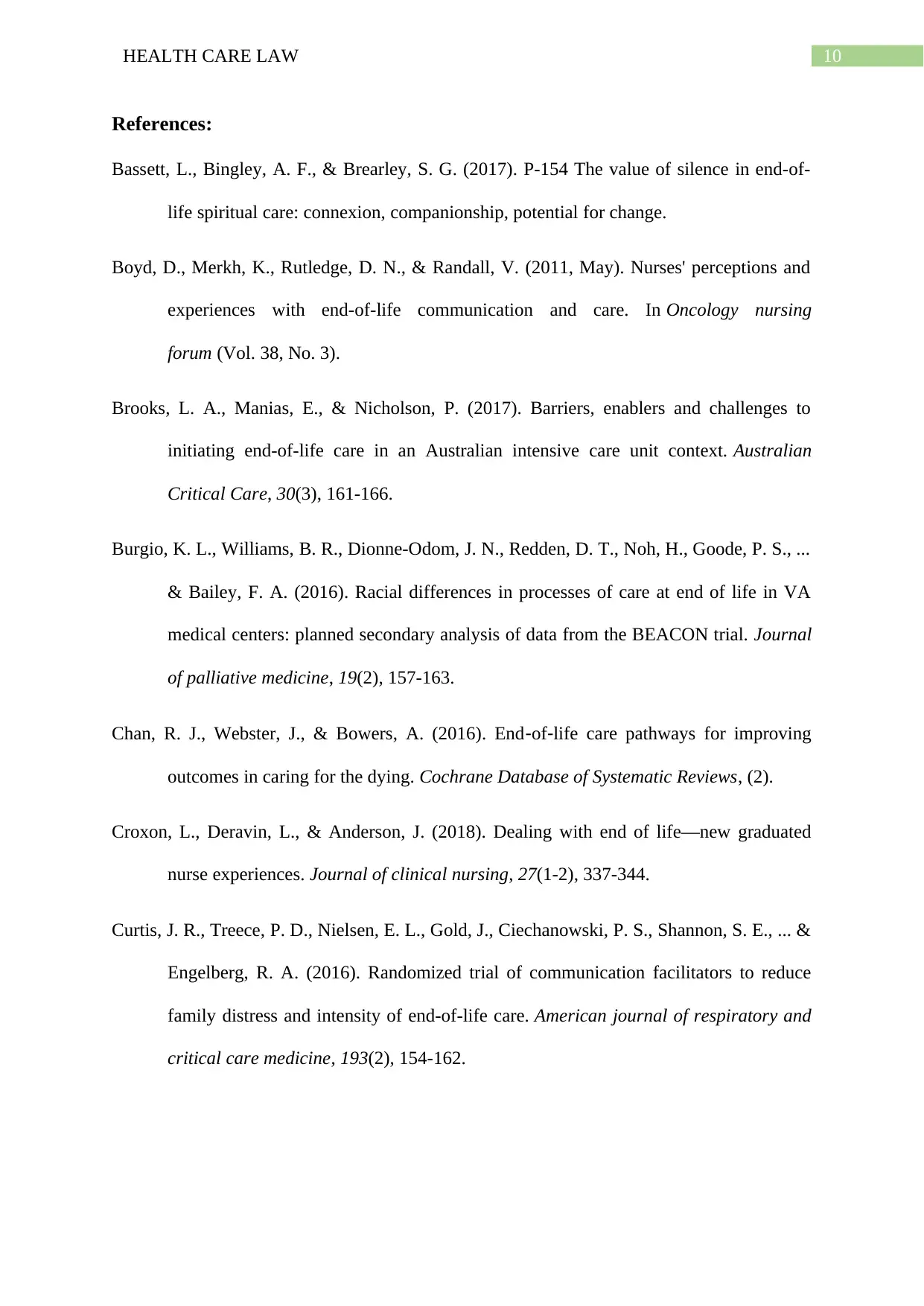
10HEALTH CARE LAW
References:
Bassett, L., Bingley, A. F., & Brearley, S. G. (2017). P-154 The value of silence in end-of-
life spiritual care: connexion, companionship, potential for change.
Boyd, D., Merkh, K., Rutledge, D. N., & Randall, V. (2011, May). Nurses' perceptions and
experiences with end-of-life communication and care. In Oncology nursing
forum (Vol. 38, No. 3).
Brooks, L. A., Manias, E., & Nicholson, P. (2017). Barriers, enablers and challenges to
initiating end-of-life care in an Australian intensive care unit context. Australian
Critical Care, 30(3), 161-166.
Burgio, K. L., Williams, B. R., Dionne-Odom, J. N., Redden, D. T., Noh, H., Goode, P. S., ...
& Bailey, F. A. (2016). Racial differences in processes of care at end of life in VA
medical centers: planned secondary analysis of data from the BEACON trial. Journal
of palliative medicine, 19(2), 157-163.
Chan, R. J., Webster, J., & Bowers, A. (2016). End‐of‐life care pathways for improving
outcomes in caring for the dying. Cochrane Database of Systematic Reviews, (2).
Croxon, L., Deravin, L., & Anderson, J. (2018). Dealing with end of life—new graduated
nurse experiences. Journal of clinical nursing, 27(1-2), 337-344.
Curtis, J. R., Treece, P. D., Nielsen, E. L., Gold, J., Ciechanowski, P. S., Shannon, S. E., ... &
Engelberg, R. A. (2016). Randomized trial of communication facilitators to reduce
family distress and intensity of end-of-life care. American journal of respiratory and
critical care medicine, 193(2), 154-162.
References:
Bassett, L., Bingley, A. F., & Brearley, S. G. (2017). P-154 The value of silence in end-of-
life spiritual care: connexion, companionship, potential for change.
Boyd, D., Merkh, K., Rutledge, D. N., & Randall, V. (2011, May). Nurses' perceptions and
experiences with end-of-life communication and care. In Oncology nursing
forum (Vol. 38, No. 3).
Brooks, L. A., Manias, E., & Nicholson, P. (2017). Barriers, enablers and challenges to
initiating end-of-life care in an Australian intensive care unit context. Australian
Critical Care, 30(3), 161-166.
Burgio, K. L., Williams, B. R., Dionne-Odom, J. N., Redden, D. T., Noh, H., Goode, P. S., ...
& Bailey, F. A. (2016). Racial differences in processes of care at end of life in VA
medical centers: planned secondary analysis of data from the BEACON trial. Journal
of palliative medicine, 19(2), 157-163.
Chan, R. J., Webster, J., & Bowers, A. (2016). End‐of‐life care pathways for improving
outcomes in caring for the dying. Cochrane Database of Systematic Reviews, (2).
Croxon, L., Deravin, L., & Anderson, J. (2018). Dealing with end of life—new graduated
nurse experiences. Journal of clinical nursing, 27(1-2), 337-344.
Curtis, J. R., Treece, P. D., Nielsen, E. L., Gold, J., Ciechanowski, P. S., Shannon, S. E., ... &
Engelberg, R. A. (2016). Randomized trial of communication facilitators to reduce
family distress and intensity of end-of-life care. American journal of respiratory and
critical care medicine, 193(2), 154-162.
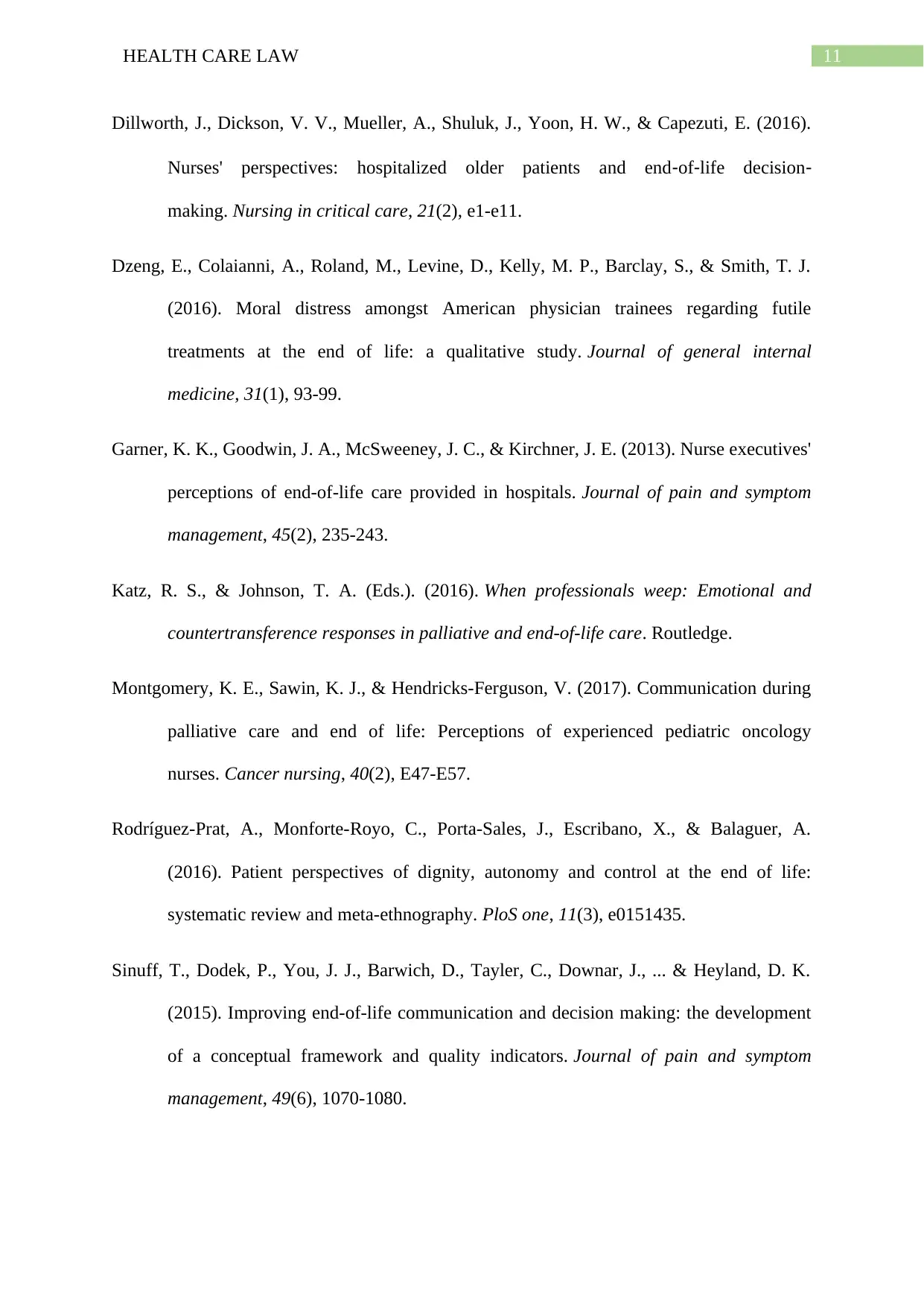
11HEALTH CARE LAW
Dillworth, J., Dickson, V. V., Mueller, A., Shuluk, J., Yoon, H. W., & Capezuti, E. (2016).
Nurses' perspectives: hospitalized older patients and end‐of‐life decision‐
making. Nursing in critical care, 21(2), e1-e11.
Dzeng, E., Colaianni, A., Roland, M., Levine, D., Kelly, M. P., Barclay, S., & Smith, T. J.
(2016). Moral distress amongst American physician trainees regarding futile
treatments at the end of life: a qualitative study. Journal of general internal
medicine, 31(1), 93-99.
Garner, K. K., Goodwin, J. A., McSweeney, J. C., & Kirchner, J. E. (2013). Nurse executives'
perceptions of end-of-life care provided in hospitals. Journal of pain and symptom
management, 45(2), 235-243.
Katz, R. S., & Johnson, T. A. (Eds.). (2016). When professionals weep: Emotional and
countertransference responses in palliative and end-of-life care. Routledge.
Montgomery, K. E., Sawin, K. J., & Hendricks-Ferguson, V. (2017). Communication during
palliative care and end of life: Perceptions of experienced pediatric oncology
nurses. Cancer nursing, 40(2), E47-E57.
Rodríguez-Prat, A., Monforte-Royo, C., Porta-Sales, J., Escribano, X., & Balaguer, A.
(2016). Patient perspectives of dignity, autonomy and control at the end of life:
systematic review and meta-ethnography. PloS one, 11(3), e0151435.
Sinuff, T., Dodek, P., You, J. J., Barwich, D., Tayler, C., Downar, J., ... & Heyland, D. K.
(2015). Improving end-of-life communication and decision making: the development
of a conceptual framework and quality indicators. Journal of pain and symptom
management, 49(6), 1070-1080.
Dillworth, J., Dickson, V. V., Mueller, A., Shuluk, J., Yoon, H. W., & Capezuti, E. (2016).
Nurses' perspectives: hospitalized older patients and end‐of‐life decision‐
making. Nursing in critical care, 21(2), e1-e11.
Dzeng, E., Colaianni, A., Roland, M., Levine, D., Kelly, M. P., Barclay, S., & Smith, T. J.
(2016). Moral distress amongst American physician trainees regarding futile
treatments at the end of life: a qualitative study. Journal of general internal
medicine, 31(1), 93-99.
Garner, K. K., Goodwin, J. A., McSweeney, J. C., & Kirchner, J. E. (2013). Nurse executives'
perceptions of end-of-life care provided in hospitals. Journal of pain and symptom
management, 45(2), 235-243.
Katz, R. S., & Johnson, T. A. (Eds.). (2016). When professionals weep: Emotional and
countertransference responses in palliative and end-of-life care. Routledge.
Montgomery, K. E., Sawin, K. J., & Hendricks-Ferguson, V. (2017). Communication during
palliative care and end of life: Perceptions of experienced pediatric oncology
nurses. Cancer nursing, 40(2), E47-E57.
Rodríguez-Prat, A., Monforte-Royo, C., Porta-Sales, J., Escribano, X., & Balaguer, A.
(2016). Patient perspectives of dignity, autonomy and control at the end of life:
systematic review and meta-ethnography. PloS one, 11(3), e0151435.
Sinuff, T., Dodek, P., You, J. J., Barwich, D., Tayler, C., Downar, J., ... & Heyland, D. K.
(2015). Improving end-of-life communication and decision making: the development
of a conceptual framework and quality indicators. Journal of pain and symptom
management, 49(6), 1070-1080.
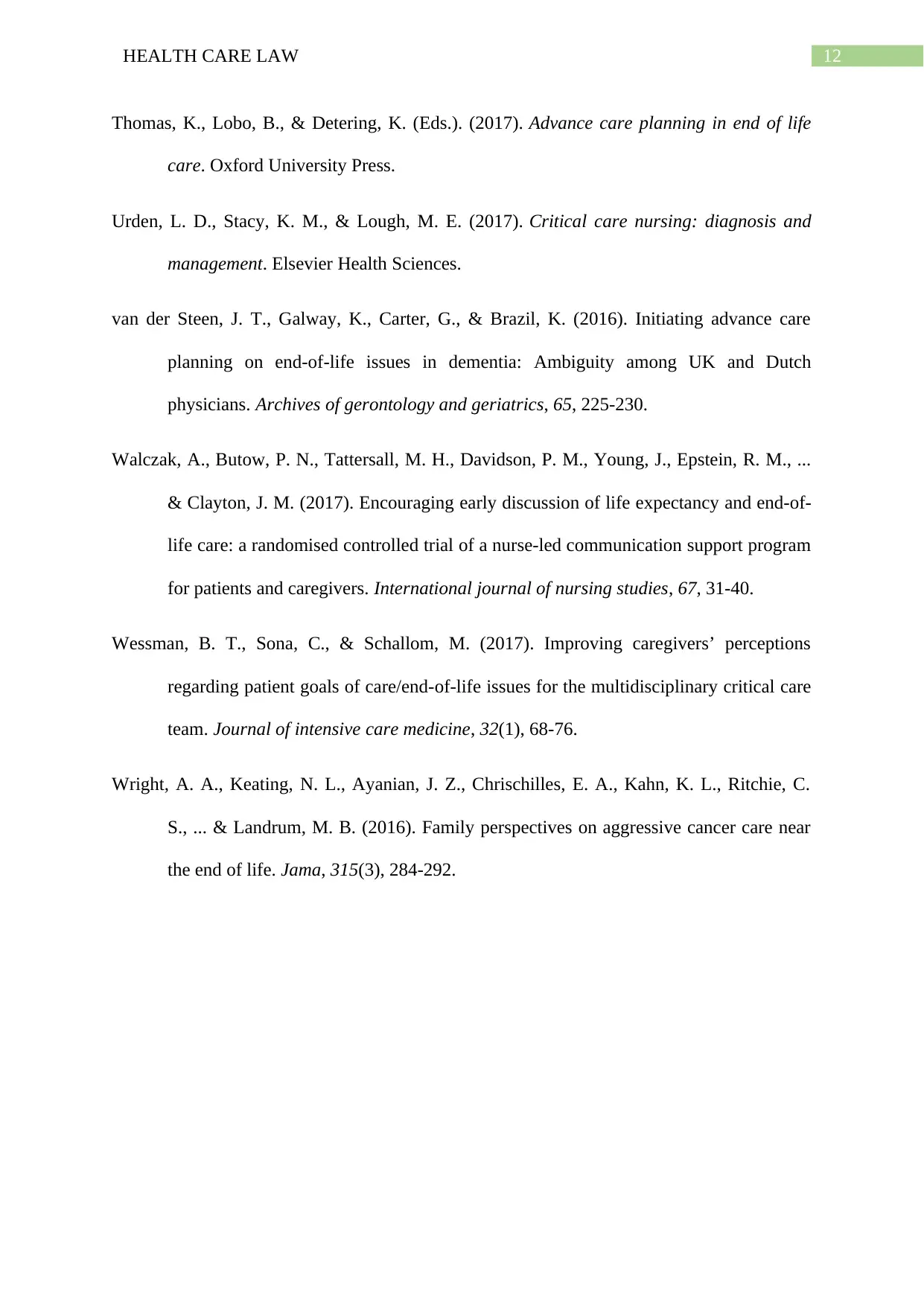
12HEALTH CARE LAW
Thomas, K., Lobo, B., & Detering, K. (Eds.). (2017). Advance care planning in end of life
care. Oxford University Press.
Urden, L. D., Stacy, K. M., & Lough, M. E. (2017). Critical care nursing: diagnosis and
management. Elsevier Health Sciences.
van der Steen, J. T., Galway, K., Carter, G., & Brazil, K. (2016). Initiating advance care
planning on end-of-life issues in dementia: Ambiguity among UK and Dutch
physicians. Archives of gerontology and geriatrics, 65, 225-230.
Walczak, A., Butow, P. N., Tattersall, M. H., Davidson, P. M., Young, J., Epstein, R. M., ...
& Clayton, J. M. (2017). Encouraging early discussion of life expectancy and end-of-
life care: a randomised controlled trial of a nurse-led communication support program
for patients and caregivers. International journal of nursing studies, 67, 31-40.
Wessman, B. T., Sona, C., & Schallom, M. (2017). Improving caregivers’ perceptions
regarding patient goals of care/end-of-life issues for the multidisciplinary critical care
team. Journal of intensive care medicine, 32(1), 68-76.
Wright, A. A., Keating, N. L., Ayanian, J. Z., Chrischilles, E. A., Kahn, K. L., Ritchie, C.
S., ... & Landrum, M. B. (2016). Family perspectives on aggressive cancer care near
the end of life. Jama, 315(3), 284-292.
Thomas, K., Lobo, B., & Detering, K. (Eds.). (2017). Advance care planning in end of life
care. Oxford University Press.
Urden, L. D., Stacy, K. M., & Lough, M. E. (2017). Critical care nursing: diagnosis and
management. Elsevier Health Sciences.
van der Steen, J. T., Galway, K., Carter, G., & Brazil, K. (2016). Initiating advance care
planning on end-of-life issues in dementia: Ambiguity among UK and Dutch
physicians. Archives of gerontology and geriatrics, 65, 225-230.
Walczak, A., Butow, P. N., Tattersall, M. H., Davidson, P. M., Young, J., Epstein, R. M., ...
& Clayton, J. M. (2017). Encouraging early discussion of life expectancy and end-of-
life care: a randomised controlled trial of a nurse-led communication support program
for patients and caregivers. International journal of nursing studies, 67, 31-40.
Wessman, B. T., Sona, C., & Schallom, M. (2017). Improving caregivers’ perceptions
regarding patient goals of care/end-of-life issues for the multidisciplinary critical care
team. Journal of intensive care medicine, 32(1), 68-76.
Wright, A. A., Keating, N. L., Ayanian, J. Z., Chrischilles, E. A., Kahn, K. L., Ritchie, C.
S., ... & Landrum, M. B. (2016). Family perspectives on aggressive cancer care near
the end of life. Jama, 315(3), 284-292.
1 out of 13
Related Documents
Your All-in-One AI-Powered Toolkit for Academic Success.
+13062052269
info@desklib.com
Available 24*7 on WhatsApp / Email
![[object Object]](/_next/static/media/star-bottom.7253800d.svg)
Unlock your academic potential
© 2024 | Zucol Services PVT LTD | All rights reserved.





